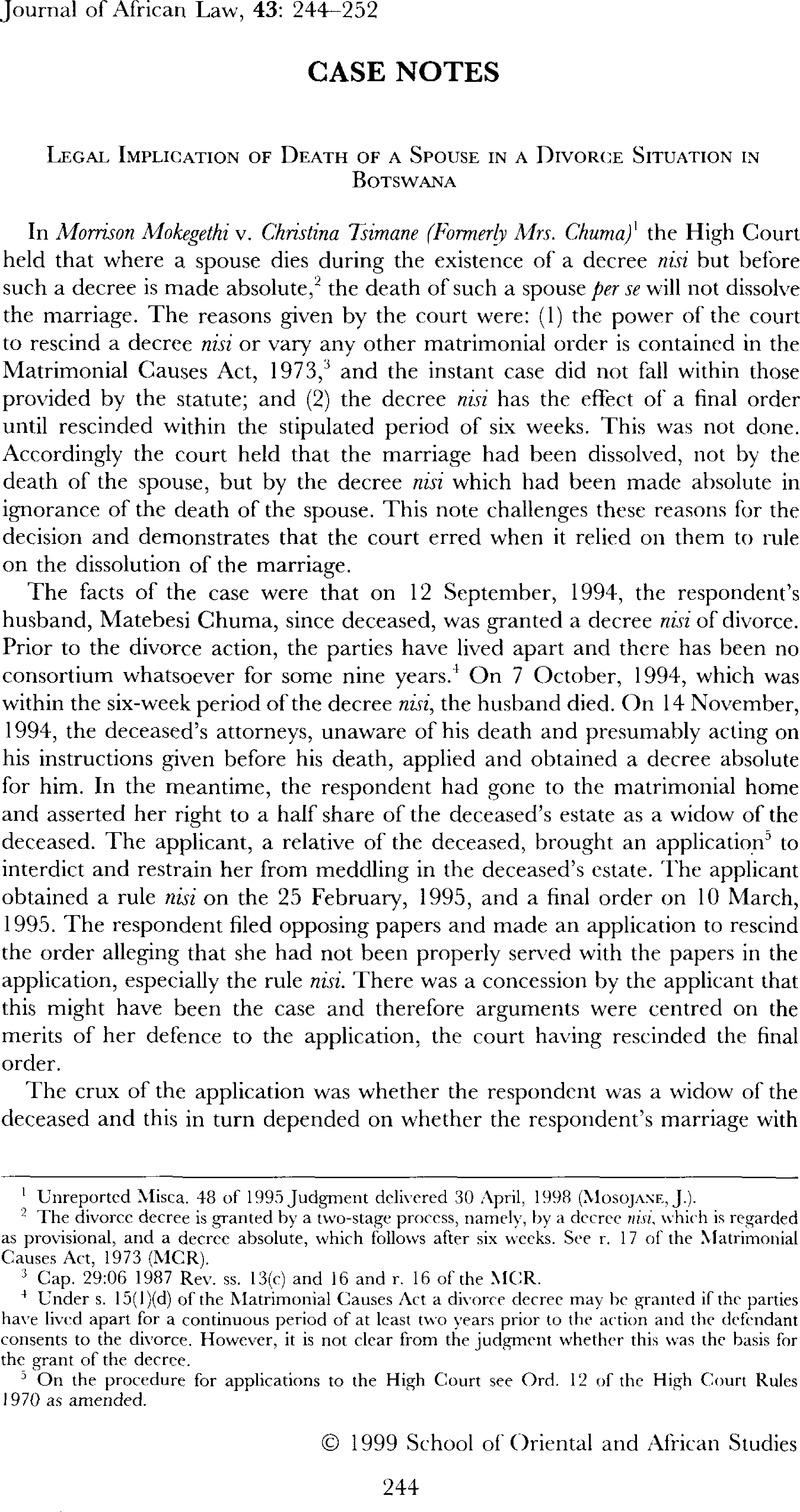No CrossRef data available.
Published online by Cambridge University Press: 28 July 2009

1 Unreported Misca. 48 of 1995 Judgment delivered 30 April, 1998 (Mosojane, J.).Google Scholar
2 The divorce decree is granted by a two-stage process, namely, by a decree nisi, which is regarded as provisional, and a decree absolute, which follows after six weeks. See r. 17 of the Matrimonial Causes Act, 1973 (MCR).
3 Cap. 29:06 1987 Rev. ss. 13(c) and 16 and r. 16 of the MCR.
4 Under s. 15(1)(d) of the Matrimonial Causes Act a divorce decree may be granted if the parties have lived apart for a continuous period of at least two years prior to the action and the defendant consents to the divorce. However, it is not clear from the judgment whether this was the basis for the grant of the decree.
5 On the procedure for applications to the High Court see Ord. 12 of the High Court Rules 1970 as amended.
6 The English cases relied upon were Sinclair v. Fell [1913] Ch. 155, Wiggins v. Wiggins [1958] 2 All E.R. 555 andGoogle ScholarFender v. Mildmay [1937] 3 All E.R. 402.Google Scholar
7 At 3—4 of the transcript.
8 See n. 3 above.
9 See n. 6 above.
10 At 4—5 of the transcript.
11 See the English case Manser v. Manser [1940] P. 224 at 230 per Langton, J.Google Scholar
12 For an example of an effect of a decree nisi on a marriage, see the English case of R. v. O'Brien [1974] 3 All E.R. 663, where a husband was convicted of raping his wife.Google Scholar
13 See n. 6 above.
14 See dicta in Fender v. Mildmay per Lord Atkin at 410E and per Lord Russell. at 417H and 418A respectively.
15 [1968] P. 53.
16 The Matrimonial Causes Act was principally based on the English Divorce Reform Act, 1969, as evident from the Memorandum accompanying the Bill which was eventually passed. Consequently, interpretation of the English statute as consolidated in the Matrimonial Causes Act, 1973, should provide persuasive authority for the Botswana courts. See further, Himsworth, C. M. G. “Effects of Matrimonial Causes Legislation in Botswana” [1974 J J.A.L. 173 andGoogle ScholarSanders, A. J. G. M., “Ten years of the Botswana Matrimonial Causes Act further proposals for divorce reform” [1982] J.A.L. 163.Google Scholar
17 This is an English common law principle that dates back a judicial act to the first moment of the day. See Clarke v. Bradlaugh (1881) 8 QBD 63 (CA)Google Scholar and Edwards v. The Queen (1854) 9 Exch. 628.Google Scholar
18 At 69E. Under the Botswana common law, which is similar to that of South Africa, the legal subjectivity of a person is terminated by death; such a person can have neither rights nor obligations. See the South African case of Parity Insurance Co. Ltd. v. Van den Bergh 1966 (4) S.A. 463 (AD).Google Scholar
19 (1886) 11 P.D. 103.Google Scholar
20 At 108.
21 At 110.
22 At 2 of the transcript.
23 At 411G H.
24 1965 (4) S.A. 449 (Γ) at p. 451 B per De Villiers, A.J.Google Scholar